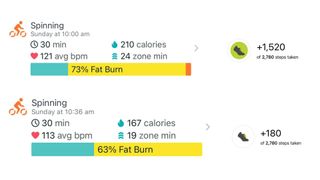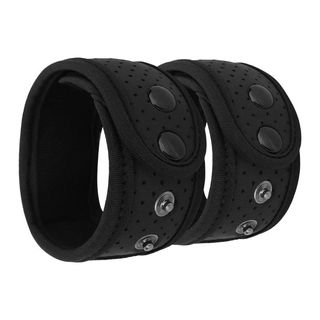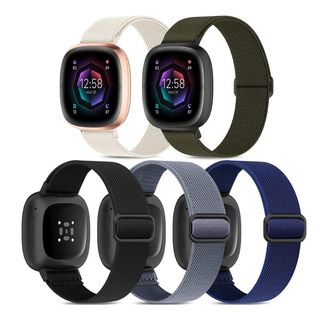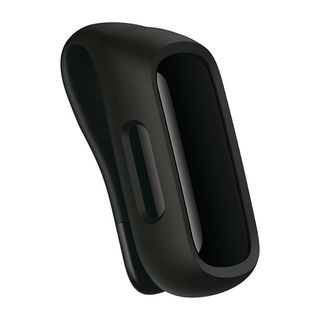I wore my Fitbit on my ankle for a week - here's what happened
Wondering if you can wear your Fitbit on your ankle? Here's what happened when I tried it for a week


Wondering if you can wear your Fitbit on your ankle? I started to ask the same question after trying to get my step count up recently and, as it turns out, it's a popular one. Online forums are filled with other users' experiences of wearing fitness trackers on different body parts.
I've been a Fitbit fan for the last few years, having upgraded to one of the best fitness trackers for women after wearing out my old one. I love the brand, both as someone who exercises almost every day and as the digital health editor at woman&home. Generally, they are great trackers for keeping tabs on your workouts, daily movement, and general health, with an ever-growing offering from Fitbit Premium only levelling up the brand more every year.
However, I've never considered whether the range of excellent features would work when wearing the device somewhere other than my wrist. All the best Fitbits are made for wearing in this specific spot, so I was interested to see whether putting it on my ankle - another area close to a large artery, so capable of taking my heart rate - would work. Here's what I discovered, plus, the advantages and disadvantages of doing so when it comes to recording daily metrics.
Can I wear my Fitbit on my ankle?
Yes, you can wear your Fitbit on your ankle. Providing you can make the strap fit, nothing is stopping you from doing so. You might even find that some of the metrics improve - such as the recording of your step count. However, the brand doesn't actively recommend doing so since this wasn't the intended placement.
I wore the Fitbit Versa 4, one of the newest Fitbits in the range, on my ankle for a week to see what happened. While I couldn't wear it for 24 hours a day on my ankle as the strap was a little too tight, I did test it out for a couple of hours every day. I put the device through its paces during a few exercise sessions and overnight to assess the difference between wearing the device on my wrist and ankle.
It was a pretty successful experiment overall. The device picked up my heart rate and step count well in both spots and I didn't notice much difference between the two even when I tried the same walk on different days, wearing my Fitbit on my ankle one day and the device on my wrist the next. Overall, I noticed that I picked up an average of 130 more steps on a walking workout when I wore the device on my ankle in comparison to when I wore it on my wrist.
There was a huge difference in the number of steps the device picked up on a stationary bike though. This isn't so much of a problem as step count likely won't be the main statistic you're monitoring during a spin class or indoor cycling session, but it was surprising to see that I picked up 1,510 extra steps when wearing the Fitbit on my ankle for 30 minutes on a stationary bike compared to when I wore it on my wrist, where I saw an increase of just 180 steps.
Sign up for the woman&home newsletter
Sign up to our free daily email for the latest royal and entertainment news, interesting opinion, expert advice on styling and beauty trends, and no-nonsense guides to the health and wellness questions you want answered.
When I was switching between the sessions, I also found some issues with the device picking up my heart rate again when I moved the Fitbit off my ankle and back onto my wrist, which may have contributed to the discrepancy in calories burnt.
If you're doing an exercise where your hands are still for most of it but your legs are moving, and you're focusing on raising your step count, it may be better to wear the watch on your ankle.

Wearing a Fitbit on my ankle (top workout) picked up more steps than wearing it on my wrist (bottom workout).
I also tried out the Fitbit on ankle for a couple of hours during the night. This is where I saw the primary downside to wearing the device on my ankle versus my wrist. When I wore the Fitbit on my ankle, the device didn't pick up any record of the hours I'd slept or the quality of my sleep. It was as if I wasn't wearing the device at all. Yet, when I wore it on my wrist as usual, it worked perfectly well, picking up all the advanced sleep statistics via Fitbit Premium.
So will I be making this a permanent lifestyle change? Probably not. Most Fitbit types are designed to be worn around the wrist, so they're naturally more comfortable, better looking, and ultimately more effective when they're worn for their original purpose. The only exception to this is the Fitbit Inspire 2 for which you can buy a specially designed silicone clip to wear the device on another part of your body, such as your waistband or bra strap.
Benefits of wearing a Fitbit on your ankle
1. Better step count
Everyone has different reasons for wearing a Fitbit, from wanting to explore all the benefits of running to getting better insights into a sleep schedule and learning how to sleep better. But one of the main advantages is an improved step count, a feature that's been integral to the brand since they launched their very first watch.
Why is the step count better when you wear the device on your ankle? It's a good question. When you wear your watch on your wrist, you have to swing or move your arms in some way when you walk for the device to always recognise that you're on the move. This isn't a problem for me and I've never noticed my step count be far away from what it should be - or what my Apple Health app suggests I've done - but if your primary goal is monitoring your steps then my experience shows having the watch on your ankle does pick up more steps.
2. Keep your wrists free
The Fitbit Luxe was designed with style specifically in mind and I wear my Fitbit Versa 4 most days, no matter the occasion since it's relatively sleek-looking and discreet. I can't say the same for Fitbits across the range. Some of them look like fitness trackers, which I find isn't a problem in day-to-day life, but if you're out at a social occasion and you don't fancy flexing your step count to your family or friends, wearing your Fitbit on your ankle is a great way to keep your wrists free for a slightly more fashionable timekeeper.
Plus, one of the downsides of the traditional Infinity Fitbit straps is that they can leave a small rash on your wrist if they get wet and don't dry properly, or you wear it for weeks at a time without a break. The brand suggests avoiding both of these scenarios, but it's easy to forget when you're committed to tracking your metrics. It's also one of the key things you need to know before buying a fitness tracker as they can't be worn all the time. Wearing my Fitbit on my ankle offered my skin a break from the strap for a couple of hours a day and during the sweatier workouts, while still tracking some important metrics like my heart rate and step count.

Wearing the Fitbit on the inside of your ankle brings the heart rate sensor closer to your artery.
3. You can forget it's there
When I wore my Fitbit on my ankle, I completely forgot it was there at all. Not only did this mean I couldn't aimlessly look at my stats for the day as a distraction, as I often do when I'm waiting in line for coffee in the morning, it gave me a more realistic idea of how much exercise I would do every week if I wasn't pushing myself based on what my Fitbit said.
For example, if I'd only met 75 minutes of my total 150 Active Zone Minute goal and I had my watch buzzing away on my wrist telling me this, I'd probably head out on a run for 20 minutes after work - but I may have been better off resting. When wearing a Fitbit on ankle, you're only likely to find out your statistics for the day when you take the device off, so you learn to be more in-tune with how your body feels rather than solely focusing on what the stats say.
Are there are downsides of wearing a Fitbit on your ankle?
There are a couple of general downsides to wearing your Fitbit on your ankle, aside from the fact that you'll lose many of the brand's essential health tracking metrics like your sleep score, you won't have access to the same fitness apps, and the company themselves don't actively recommend it.
Firstly, if you plan to wear the Fitbit on ankle, you'll need to invest in a new strap. The Infinity strap that came with my model wasn't really big enough to be worn for an extended period - but I was dedicated to the experiment. Unless you've got ankles of a similar size to your wrists, it's unlikely that your strap is going to fit comfortably around your ankle for longer than a few hours at a time. Finding a Fitbit ankle band, like the ones below, is definitely the way forward.

Looking to wear any of the Fitbit Charge or Inspire models on your ankle? This is a specially-designed Fitbit ankle band, an alternative to the bands provided officially by Fitbit for those looking to try this alternative position.
Secondly, you won't be able to utilise another primary feature of the watch - checking the time and receiving notifications. As it's strapped to the inside of your ankle, you'll probably need to wear an alternative smartwatch on your wrist if you plan to be able to check the time or receive texts, calls, and calendar notifications. You'll still get these on your Fitbit if you wear it on your ankle but from my experience, it's very difficult to bring your foot close enough to your face when walking along to check these notifications - and it looks a bit odd too.
If you're committed to a fitness tracker that doesn't live on your wrist, there are other options - including smart rings like Oura and heart rate monitors, which sit around your chest and include those old by brands like Garmin and Polar. As noted as well, the Inspire 2 fits in a tidy clip. As it's all Fitbit-approved, you know it'll work and you can attach the device to your waistband, belt, pocket, or bra, without having any contact with the skin.

Grace Walsh is woman&home's Health Channel Editor, working across the areas of fitness, nutrition, sleep, mental health, relationships, and sex. She is also a qualified fitness instructor. In 2024, she will be taking on her second marathon in Rome, cycling from Manchester to London (350km) for charity, and qualifying as a certified personal trainer and nutrition coach.
A digital journalist with over six years experience as a writer and editor for UK publications, Grace has covered (almost) everything in the world of health and wellbeing with bylines in Cosmopolitan, Red, The i Paper, GoodtoKnow, and more.
-
 Kate Middleton’s cranberry red jumper dress is the most elegant low-key alternative to festive dresses and knits
Kate Middleton’s cranberry red jumper dress is the most elegant low-key alternative to festive dresses and knitsThe Princess of Wales once wore a splendid festive red jumper dress and it's got us excited to wear this colour more this Christmas
By Emma Shacklock Published
-
 The woman&home beauty team have our Christmas nails sorted – these are the chic designs we settled on
The woman&home beauty team have our Christmas nails sorted – these are the chic designs we settled onStuck for Christmas nail inspiration? These are the exact party-ready manicure looks our very own team has chosen...
By Naomi Jamieson Published

